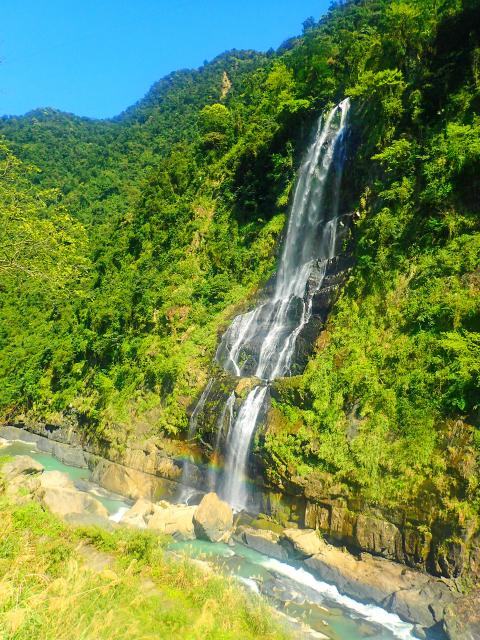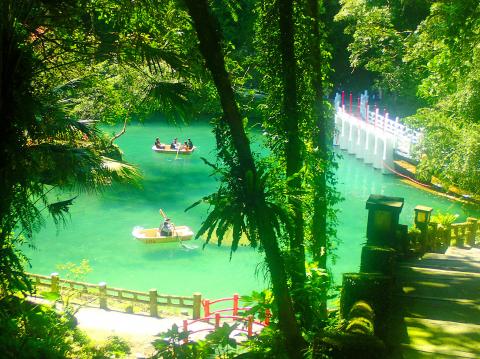Outside of the Alps, I can’t think of many places where you can end a hike with a cable car ride, and although Taiwan presently only has two tourist cable cars, one of them is in a position to offer just that.
The hot-springs-and-waterfalls resort of Wulai (烏來), in the mountains south of Taipei, is one of those places that just about every visitor to Taiwan gets to at some point in their stay. Milking its tempting attractions (clear, odorless hot springs, colorful Atayal Aboriginal inhabitants and magnificent scenery) to the full, Wulai is definitely not the direction to head in search of seclusion, unspoilt beauty and exploration.
Or is it?

Photo: Richard Saunders
Wulai may be overrun with day trippers on fine weekends (it’s not exactly quiet during the week either), but the multitudes stick to a very well-defined and limited area, leaving most of the surrounding wild scenery to a slowly growing yet still small minority of hikers. The area suffered hugely from flooding and mudslides bought on by Typhoon Soudelor, which struck in early August 2015, dumping 72 centimeters of rain on the area in just 24 hours. Two-and-a-half years later, things are virtually back to normal, and although the center of the village still looks a bit unsightly as repairs continue, Wulai’s trails are definitely once again open for hikers.
As I said, there’s plenty of magnificent countryside to explore in the Wulai area. Get off the road and there’s some wild and remote terrain out there which shouldn’t be tackled without a good map and experience. One hike, however, that manages to be relatively wild and exhilarating while not straying too far from civilization is the Laka Trail (啦卡步道), a short, steep ramble from Wulai village to the top of the famous Wulai Waterfall (烏來瀑布).
Starting at the car park and bus terminus in Wulai, follow the crowds along the road through town beside the river for a couple hundred meters, then branch left along a tributary stream immediately after crossing the first bridge. Shortly, opposite Wulai elementary school, the pure, emerald-green water of the stream cuts its way through a glen called Mini Gorge (迷你谷). Its beauty was destroyed temporarily by the vast amounts of mud and stone swept down by Soudelor, but time is healing the scars and returning the place to its former loveliness. Moving on, the way to the start of the Laka Trail is a little further down the road on the right, at a flight of concrete steps. Climb these and turn left at the top onto another road. A few meters down it, turn right again up another flight of wide steps that cut off a zigzag in the road.

Photo: Richard Saunders
At the top of the steps turn left once more, and at a sharp bend, turn right, beside a house, onto a wide dirt trail (marked by a board map) which zigzags up the steep, wooded hillside for about half an hour to the start of the Laka Trail itself, marked by an electricity pylon. The trail almost immediately starts climbing steeply, with ropes to help on the tougher bits. An especially lovely section climbs through an old plantation of conifers: an eerily atmospheric place during the frequent mists that descend on these hills, when the trees’ tall, straight trunks disappear into the clammy white haze above.
The trail finally joins a wider path of rather ugly stone steps just before the ridge. Here is the finest view of the whole hike, looking out over Wulai village, hundreds of meters below, and a meandering, green-blue stretch of the Beishi River (北勢溪).
The trail now sticks quite close to the edge of the Beishi River gorge, whose steep, tree-covered slopes turn into high, sheer cliffs as the rocky path climbs to the highest point of the walk, Big Knife Mountain (or Mount Dadao, 大刀山, 620 meters), although sadly there’s no view. The distant, muffled shouts of happy day trippers down in the gorge far below waft up on breezes, and at intervals the strange whooshing sound of the engine propelling the cable car upwards to nearby Yunhsien Dreamland (雲仙樂園) can be heard through the trees.

Photo: Richard Saunders
The descent from Big Knife Mountain is steep and slippery, so take care. At the bottom turn right beside a stream, then along a narrow and treacherously slippery trail that veers left away from it to descend to the back of Yunhsien Dreamland.
Damage from Typhoon Soudelor is apparent here, but within a few steps the amusement park, which was established during the Japanese colonial era, has been cleaned up, and it’s a lovely place to rest and maybe have lunch (there’s a Chinese restaurant and coffee shop if you forgot your sandwiches).
Finally follow the wide concrete path downhill beside the stream as it plunges into a deep hanging valley over several waterfalls, en route to the big plunge of Wulai Waterfall itself, to the upper cable car station. Hikers might be asked to pay for the ride down, but since at least some of the cable car operators seem unaware of the existence of the trail, there’s a chance you’ll get a free ride.
In any event, the ride down is short but spectacular, especially when the car floats out over the brink of the great waterfall, giving fantastic views of its snow-white horsetails, before coming to rest in the tourist village that has built up at the foot of the waterfall. It’s a unique way and fun to finish the hike.
From the lower cable car station, walk down the steps to the lower street for the best views of the imposing waterfall, and walk downstream for 25 minutes back to the car park and bus stop. The old free outdoor hot spring pools, beside the river below the bridge, are sadly no more, but informal pools of hot spring water can still be found (or dug) in the river bank, and are a great place to soak tired muscles, while admiring the view back up the gorge and the wooded heights above, along which, unknown to most visitors, lies the exciting Laka Trail.
Richard Saunders is a classical pianist and writer who has lived in Taiwan since 1993. He’s the founder of a local hiking group, Taipei Hikers, and is the author of six books about Taiwan, including Taiwan 101 and Taipei Escapes. Visit his Web site at www.taiwanoffthebeatentrack.com.

One of the biggest sore spots in Taiwan’s historical friendship with the US came in 1979 when US president Jimmy Carter broke off formal diplomatic relations with Taiwan’s Republic of China (ROC) government so that the US could establish relations with the People’s Republic of China (PRC). Taiwan’s derecognition came purely at China’s insistence, and the US took the deal. Retired American diplomat John Tkacik, who for almost decade surrounding that schism, from 1974 to 1982, worked in embassies in Taipei and Beijing and at the Taiwan Desk in Washington DC, recently argued in the Taipei Times that “President Carter’s derecognition

This year will go down in the history books. Taiwan faces enormous turmoil and uncertainty in the coming months. Which political parties are in a good position to handle big changes? All of the main parties are beset with challenges. Taking stock, this column examined the Taiwan People’s Party (TPP) (“Huang Kuo-chang’s choking the life out of the TPP,” May 28, page 12), the Democratic Progressive Party (DPP) (“Challenges amid choppy waters for the DPP,” June 14, page 12) and the Chinese Nationalist Party (KMT) (“KMT struggles to seize opportunities as ‘interesting times’ loom,” June 20, page 11). Times like these can

June 23 to June 29 After capturing the walled city of Hsinchu on June 22, 1895, the Japanese hoped to quickly push south and seize control of Taiwan’s entire west coast — but their advance was stalled for more than a month. Not only did local Hakka fighters continue to cause them headaches, resistance forces even attempted to retake the city three times. “We had planned to occupy Anping (Tainan) and Takao (Kaohsiung) as soon as possible, but ever since we took Hsinchu, nearby bandits proclaiming to be ‘righteous people’ (義民) have been destroying train tracks and electrical cables, and gathering in villages

Dr. Y. Tony Yang, Associate Dean of Health Policy and Population Science at George Washington University, argued last week in a piece for the Taipei Times about former president Ma Ying-jeou (馬英九) leading a student delegation to the People’s Republic of China (PRC) that, “The real question is not whether Ma’s visit helps or hurts Taiwan — it is why Taiwan lacks a sophisticated, multi-track approach to one of the most complex geopolitical relationships in the world” (“Ma’s Visit, DPP’s Blind Spot,” June 18, page 8). Yang contends that the Democratic Progressive Party (DPP) has a blind spot: “By treating any